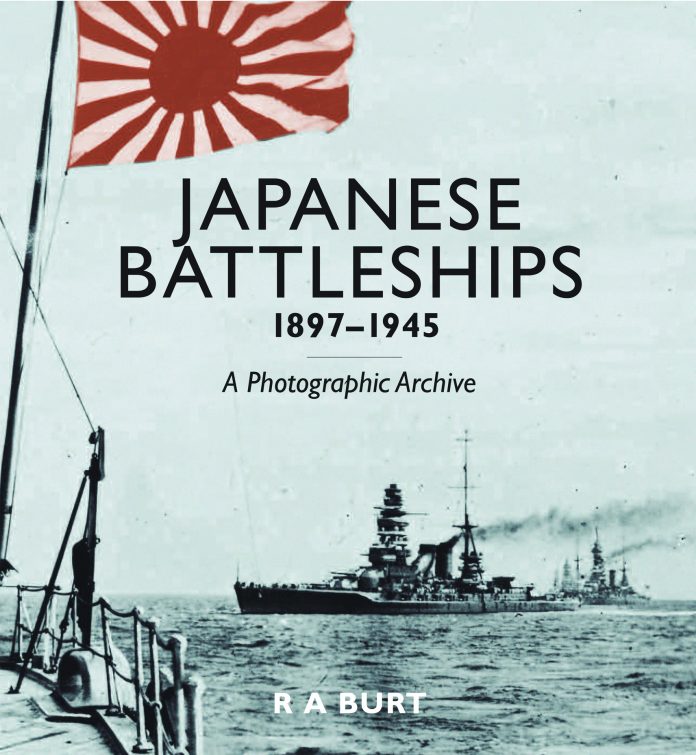
Japanese Battleships 1897 – 1945: A Photographic Archive. By R A Burt. Seaforth Publishing, Barnsley, 2015.
Reviewed by Tim Coyle
BATTLESHIP books authored by RA Burt will not disappoint the enthusiast of these departed maritime fortresses. Burt is an established authority of the genre, as his recently released new edition of British Battleships 1919–1945 is replete with all the technical details of these well-known and photogenic giants.
In Japanese Battleships 1897-1945 he favours us with a photo archive of the fascinating Imperial Japanese battle fleet which largely fell to the battleships’ nemeses: the submarine-launched torpedo and naval aircraft.
The Japanese battleship, particularly from the early 1930s, holds the enthusiast’s awe in the stupendous ‘pagoda’ masts soaring up to 150 feet above the waterline and presenting a sight somewhere between the bizarre and the grotesque. First appearing in the two-ship Kongo class in the mid-1920s the pagodas of searchlight and gunnery control platforms grew up the foremasts.
To carry this weight ships were fitted with ‘heptpodal’ (six-legged) masts which were extensively tested for structural strength and the ability to withstand enemy fire. Innovative measures were taken to shield the control platforms in the masts against funnel smoke which included smoke baffles fitted to forefunnels. Nagato and Mutsu sported enormous leaning forefunnels in the 1920s and 30s adding to their unique profiles.
These features are illustrated in contemporary photographs taken as single water level images, in fleet anchorages and in detailed close-ups. The midships image of Nagato in May 1930 shows the full treatment of pagoda and leaning funnel. The reader can engage in a comparison game of which class of Imperial Japanese Navy (IJN) battleship had the most extreme profile. Perhaps the most bizarre from the pagoda and hybrid viewpoint was Ise, depicted in April 1943 after conversion to a part-aircraft carrier.
Besides the photographs, line drawings depict the appearance changes from completion through upgrades to the battleships which participated in the Pacific war. However we are also treated to an excellent coverage of the older classes of IJN battleships most of which were constructed in British yards in the late 19th and early 20th centuries. These are high quality photographs with many double page spreads. Russian ships captured at Port Arthur and after the battle of Tsushima are also included.
As a photographic archive we are not burdened by excessive details of armour protection, machinery and gunnery specifics; however, each ship class is supported by adequate technical details with informative captions. Burt gives full credit to the battle worthiness of the later ships and the overwhelming odds they faced in the battles to their annihilations against the US Navy.
IJN ship photographs became rare in the late 1930s due to security prohibitions. Burt explains that the renowned British battleship authority of the 1920s and 30s Oscar Parkes, who had corresponded and traded photographs with a Japanese colleague, was told that the exchanges had to stop as only official photographs could be published henceforth. These, he said, were scarce and of poor quality. However there was no shortage of photographs of IJN battleships under attack by USN aircraft and we see several images of the behemoths’ pagodas bowing under the weight of aerial onslaught.
Fittingly, and poignantly, the mighty Yamato and Musashi are the last ships covered. One of the Yamato photographs shows the ship on trials at 27 knots cleaving through a white-capped sea and throwing up clouds of spray along the whole length of the hull. It must have been an awe-inspiring site for those witnessing it which probably filled them with a feeling of invincibility against the Emperor’s enemies.
Musashi is shown enroute to the Leyte Gulf battle on 22 October 1944 and the last photograph, taken two days later, is of the huge vessel down by the bow and mortally wounded after 18 bomb hits and 19 torpedoes. The photograph, taken by an IJN officer, was not processed for four years after the event by which time the mighty IJN was no more.
Japanese Battleships 1897-1945 should be on the bookshelves of students of armoured ships and their place in 20th century sea power. The IJN battleship fleet-in-being played a pivotal role in the maritime strategy of the interwar period and, during the Pacific War, were a formidable challenge to the Allies. They only succumbed after courageously confronting overwhelming odds.



